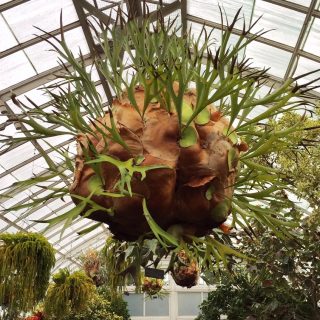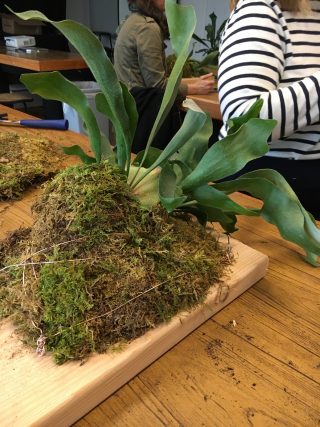How To Mount Staghorn Ferns for a Stunning Display
Posted in Adult Education on May 3 2018, by Joyce Newman
Joyce H. Newman is an environmental journalist and teacher. She holds a Certificate in Horticulture from The New York Botanical Garden.
 Staghorn ferns make a dramatic addition to any indoor plant collection. Botanically, they are epiphytes—plants that thrive while hanging onto threes or hanging in mossy baskets. In tropical environments and in NYBG’s Conservatory, mature staghorn ferns (Platycerium bifurcatum) look awesome with their huge, tan-colored, shield-like plates and green fronds shaped like antlers. The plates cover fairly shallow root balls that cling to tree trunks or other mossy homes.
Staghorn ferns make a dramatic addition to any indoor plant collection. Botanically, they are epiphytes—plants that thrive while hanging onto threes or hanging in mossy baskets. In tropical environments and in NYBG’s Conservatory, mature staghorn ferns (Platycerium bifurcatum) look awesome with their huge, tan-colored, shield-like plates and green fronds shaped like antlers. The plates cover fairly shallow root balls that cling to tree trunks or other mossy homes.
The plants get their nutrients from the trees or moss they grow on and absorb water through their fronds. Like other ferns, the staghorn variety is among the most ancient of plants. (There are an estimated 10,500 fern species, according to the American Fern Society, some dating back tens of thousands of years.) The staghorn ferns are found from the Philippines and Australia to Madagascar, Africa, and South America. Ferns do not produce flowers, but are able to reproduce by sending very tiny spores into the air. The spores form on the underside of the fertile fronds.
Not surprisingly, mounted staghorn ferns have become popular decorator plants featured on the walls of Manhattan apartments as well as suburban and country estates. Mounting the plants on wooden boards may seem daunting, but it’s easy to learn how. At NYBG’s Staghorn Fern craft class, instructor Tara Douglass explains all the necessary steps and also how to properly care for your fern indoors.
 Douglass owns the Brooklyn Plant Studio and is an experienced floral and garden designer based in Williamsburg, Brooklyn. She studied horticulture and botany at The New York Botanical Garden’s School of Professional Horticulture, and is an ISA Certified Arborist. For six years, Douglass worked in the horticulture department at Battery Park City Parks Conservancy. Her commercial retail experience includes a stint at Terrain, the garden and lifestyle store in Westport, Connecticut.
Douglass owns the Brooklyn Plant Studio and is an experienced floral and garden designer based in Williamsburg, Brooklyn. She studied horticulture and botany at The New York Botanical Garden’s School of Professional Horticulture, and is an ISA Certified Arborist. For six years, Douglass worked in the horticulture department at Battery Park City Parks Conservancy. Her commercial retail experience includes a stint at Terrain, the garden and lifestyle store in Westport, Connecticut.
The materials that are provided in Douglass’ class include a wooden board, about 12″ by 16″ for mounting, a plant that comes in a 6″ pot, lots of sphagnum moss for wrapping the root ball, gardeners’ green wire or colorful copper wire, and nails that won’t rust when wet used for fastening the wires around the moss to hold the plant on the board. If you plan to hang the board on a wall, you’ll also get screws to fasten onto the back of the board and more wire.
Douglass’ next class will be offered at NYBG’s midtown location on August 4. In the meantime, keep an eye out for these fascinating ferns at your favorite plant shop.

